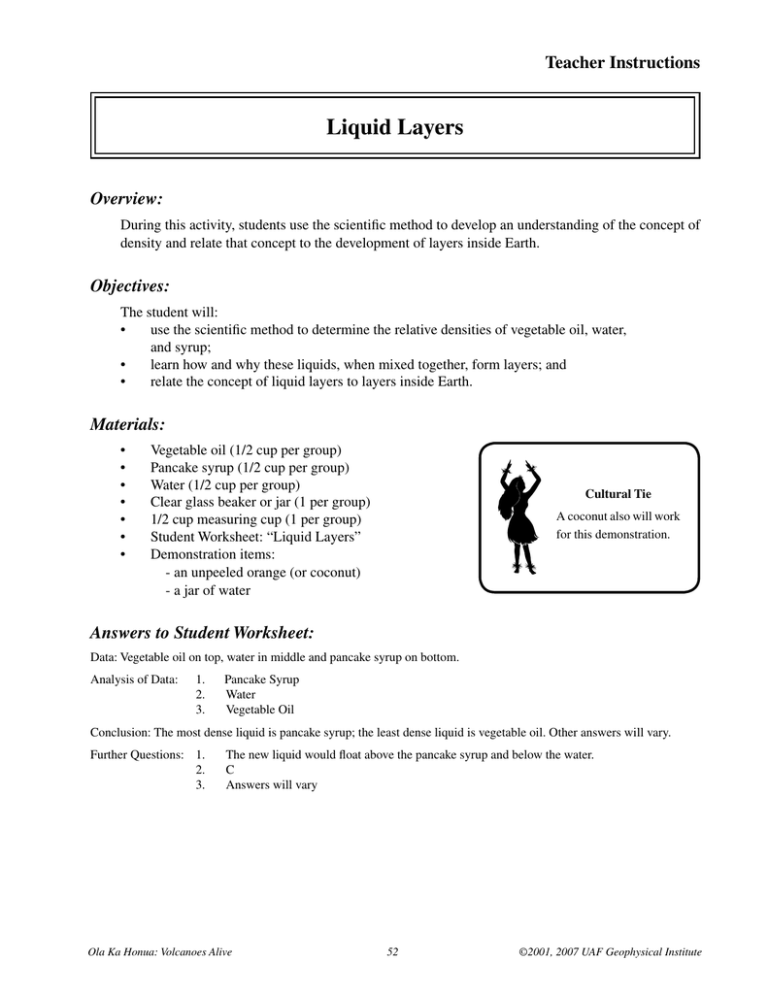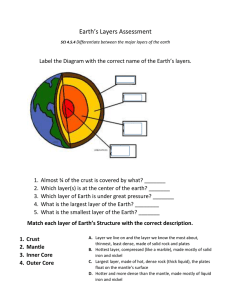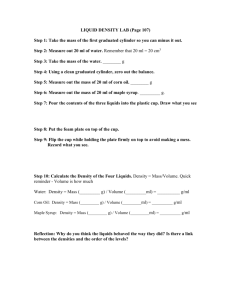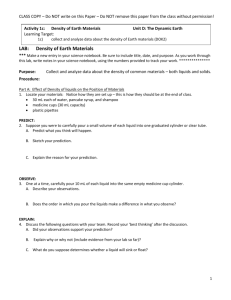Liquid Layers Teacher Instructions Overview:
advertisement

Teacher Instructions Liquid Layers Overview: During this activity, students use the scientiÞc method to develop an understanding of the concept of density and relate that concept to the development of layers inside Earth. Objectives: The student will: ¥ use the scientiÞc method to determine the relative densities of vegetable oil, water, and syrup; ¥ learn how and why these liquids, when mixed together, form layers; and ¥ relate the concept of liquid layers to layers inside Earth. Materials: ¥ ¥ ¥ ¥ ¥ ¥ ¥ Vegetable oil (1/2 cup per group) Pancake syrup (1/2 cup per group) Water (1/2 cup per group) Clear glass beaker or jar (1 per group) 1/2 cup measuring cup (1 per group) Student Worksheet: ÒLiquid LayersÓ Demonstration items: - an unpeeled orange (or coconut) - a jar of water Cultural Tie A coconut also will work for this demonstration. Answers to Student Worksheet: Data: Vegetable oil on top, water in middle and pancake syrup on bottom. Analysis of Data: 1. 2. 3. Pancake Syrup Water Vegetable Oil Conclusion: The most dense liquid is pancake syrup; the least dense liquid is vegetable oil. Other answers will vary. Further Questions: 1. 2. 3. The new liquid would ßoat above the pancake syrup and below the water. C Answers will vary Ola Ka Honua: Volcanoes Alive 52 ©2001, 2007 UAF Geophysical Institute Teacher Instructions Liquid Layers Activity Procedure: 1. Put an unpeeled orange in a jar of water. Explain that the orange ßoats because it is less dense than water. Explain that density is the ratio of the mass of a substance to its volume. All matter has density. Peel the orange and return it to the jar of water. It will sink because without the peel, the orange is more dense than water. Ask students what this experiment demonstrates about the density of an orange peel. (The orange peel is less dense than water.) 2. Divide students into groups. Distribute the Student Worksheet: ÒLiquid Layers.Ó 3. Explain that vegetable oil, pancake syrup, and water each have a different density. Ask students to predict which liquid is the most dense and which is the least dense, and record their predictions in the ÒHypothesisÓ section of the Student Worksheet: ÒLiquid Layers.Ó 4. Distribute supplies and explain that students will do an experiment to determine the relative densities of the three liquids. Ask students to use the instructions on the worksheet to perform the experiment. 5. After students have completed the experiment procedure and recorded the data, explain that the liquids have formed into layers according to their relative density. 6. Ask students which liquid is the most dense. Explain that one can tell that the syrup is the most dense because it rests at the bottom of the jar. Ask students which liquid is the least dense. Explain that one can tell that the vegetable oil is the least dense because it ßoats on top of the jar. 7. Ask students to complete the Analysis of Data and Conclusion sections of the Student Worksheet. 8. Ask students to participate in a brainstorm discussion about how the liquid layers are similar to the layers inside Earth. 9. Help students understand that the most dense material inside Earth rests in the core, and that the least dense material ÒßoatsÓ on top of the mantle as the crust. 10. Ask students to complete the Further Questions section of the Student Worksheet: ÒLiquid Layers.Ó Inquiry Extension: Ask students to drop different objects, such as an eraser and a paper clip into the jar containing liquid layers. Which objects sink and which ßoat? Do some objects sink to certain layers? Explain that the objects that ßoat are less dense than the oil and those that sink are more dense than the oil. You may wish to challenge students by asking them to Þnd something at home that will ßoat on the middle layer. Optional Teacher Demonstration: Fill two clear glasses with water. Fill a third glass with isopropyl alcohol. Do not tell students the contents of the glasses. Drop an ice cube in the Þrst two glasses. The ice cube ßoats. Drop an ice cube in the third glass. It sinks. Ask students to discuss what happened. Explain that the alcohol is less dense than water. Ola Ka Honua: Volcanoes Alive 53 ©2001, 2007 UAF Geophysical Institute Name: _________________________________________ Student Worksheet Liquid Layers Testable Question: Vegetable oil, pancake syrup and water each have different densities. Which is the most dense of these three liquids? Which is the least dense? Background Information: When poured together into a container, liquids separate according to density. The most dense liquid sinks to the bottom, while the least dense liquid ßoats on top. Hypothesis: Complete your hypothesis by Þlling in each blank space with the name of a liquid (pancake syrup, vegetable oil, or water): Of the following three liquids: vegetable oil, pancake syrup, and water, the most dense liquid is _______________________________________________, and the least dense liquid is _________________________________________________________. Materials: ¥ ¥ ¥ ¥ Beaker 1/2 cup vegetable oil 1/2 cup pancake syrup 1/2 cup water Procedure: 1. 2. 3. Pour 1/2 cup vegetable oil, 1/2 cup pancake syrup, and 1/2 cup water into a beaker. Do not stir. Observe the liquids separating (this should occur within two minutes). Record your results on the Liquid Layers Diagram in the Data section below. Data: Label each layer of the diagram with the appropriate liquid: Ola Ka Honua: Volcanoes Alive 54 ©2001, 2007 UAF Geophysical Institute Name: _________________________________________ Student Worksheet Liquid Layers Analysis of Data: 1. Which of the liquids you tested was the most dense? ______________________________________ 2. Which of the liquids you tested had a middle density when compared with the other two? ________________________________________________________________________________ 3. Which of the liquids you tested was the least dense? ______________________________________ Conclusion: Complete your conclusion by Þlling in each blank space with the name of a liquid (pancake syrup, vegetable oil, or water): Of the following three liquids; vegetable oil, pancake syrup, and water, the most dense liquid is ________________________, and the least dense liquid is___________________________. Was your hypothesis proved or disproved? Use a complete sentence. ____________________________________________________________________________________ ____________________________________________________________________________________ Brießy explain how you came to your conclusion. ____________________________________________________________________________________ ____________________________________________________________________________________ ____________________________________________________________________________________ Further Questions: 1. If you added a liquid that was less dense than pancake syrup, but more dense than water to your beaker, what do you think would happen? ________________________________________________________________________________ ________________________________________________________________________________ 2. The liquids in your experiment model how EarthÕs layers separate according to density. The diagram shows EarthÕs layers. Write the letter of the layer that has the greatest density. Layer ______________ has the greatest density. 3. A C B On the back of this page, describe the similarities and differences between the liquid layers model and the structure of EarthÕs layers. Ola Ka Honua: Volcanoes Alive 55 ©2001, 2007 UAF Geophysical Institute








